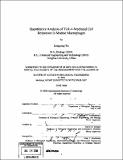| dc.contributor.advisor | Douglas A. Lauffenburger and David B. Schauer. | en_US |
| dc.contributor.author | Wu, Rongcong | en_US |
| dc.contributor.other | Massachusetts Institute of Technology. Biological Engineering Division. | en_US |
| dc.date.accessioned | 2009-03-16T19:54:54Z | |
| dc.date.available | 2009-03-16T19:54:54Z | |
| dc.date.copyright | 2008 | en_US |
| dc.date.issued | 2008 | en_US |
| dc.identifier.uri | http://hdl.handle.net/1721.1/44878 | |
| dc.description | Thesis (S.M.)--Massachusetts Institute of Technology, Biological Engineering Division, 2008. | en_US |
| dc.description | Vita. | en_US |
| dc.description | Includes bibliographical references (p. 82-89). | en_US |
| dc.description.abstract | TLR-4 is essential in host defense against bacterial infection. By recognition of specific pathogen-associated molecular patterns such as lipopolysaccharide (LPS), TLR-4 can in tandem initiate a pair of downstream signaling pathways to regulate cytokine/chemokine release, endotoxin tolerance and apoptosis, which have been suggested to directly or indirectly participate in the regulation of innate and adaptive immune responses. However, little is known about their detailed signal-response relationships. In this thesis, we sought to identify these potential signal-response relationships in RAW264.7 cells through systematic analysis. We first measured LPS stimulated dynamic signaling profiles over a range of an inhibitor of p38 MAPK, SB202190 concentrations for a distribution of kinases centrally involved in TLR-4 signaling network. We then applied quantitative analytical approaches to determine the most important signals or signal combinations contributing to induction of either IL-6 and TNF-ao secretion or apoptosis and construct their corresponding predictive mathematical models. Particularly, we found that the partial least squares regression (PLSR) models built using the ratio of phosphorylated Jun N-terminal kinase (JNK) and extracellular signal regulated kinase (ERK) predicted LPS plus SB202190-induced apoptosis accurately even following perturbation with pharmacological inhibitors of JNK and ERK. Thus, by combining experimental and computational approaches, this thesis has proposed two new potential targets, JNK and ERK, for development of drug therapies against bacterial infection. | en_US |
| dc.description.statementofresponsibility | by Rongcong Wu. | en_US |
| dc.format.extent | 89 p. | en_US |
| dc.language.iso | eng | en_US |
| dc.publisher | Massachusetts Institute of Technology | en_US |
| dc.rights | MIT theses may be protected by copyright. Please reuse MIT thesis content according to the MIT Libraries Permissions Policy, which is available through the URL provided. | en_US |
| dc.rights.uri | http://dspace.mit.edu/handle/1721.1/7582 | en_US |
| dc.subject | Biological Engineering Division. | en_US |
| dc.title | Quantitative analysis of TLR-4-mediated cell responses in murine macrophages | en_US |
| dc.type | Thesis | en_US |
| dc.description.degree | S.M. | en_US |
| dc.contributor.department | Massachusetts Institute of Technology. Department of Biological Engineering | |
| dc.identifier.oclc | 302282746 | en_US |
